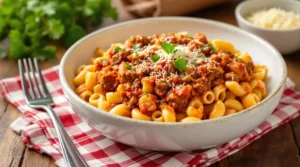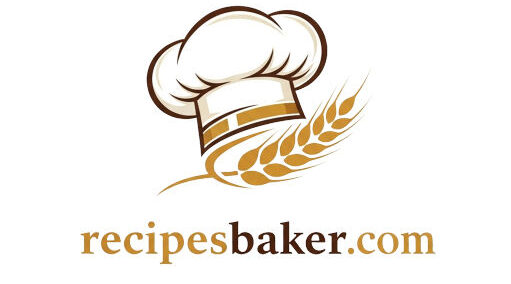There’s something about beefaroni that feels like a warm hug on a cold day. This classic comfort food has been a staple in American households for decades, bringing families together around the dinner table. Whether you grew up eating it straight out of a can or enjoyed a homemade version whipped up by a loved one, beefaroni has a way of sticking with you—both in memory and flavor.
But what exactly makes beefaroni so special? It’s not just the elbow macaroni or the savory ground beef swimming in a rich tomato sauce. It’s the nostalgia, the simplicity, and the way it reminds us of a time when life felt a little less complicated. And while the canned version from Chef Boyardee is iconic, there’s a whole world of homemade recipes that take this dish to the next level. If you’re curious about the history of this beloved dish, the Smithsonian Magazine has a fascinating article on how Chef Boyardee became a household name.

The Origins of this iconic pasta dish
Beefaroni didn’t just appear out of thin air—it has a story, and it’s one worth telling. The dish owes much of its fame to Chef Hector Boiardi, better known as Chef Boyardee. In the 1920s, Boiardi began selling his Italian-inspired meals in cans, making it easier for busy families to enjoy hearty, flavorful dishes without spending hours in the kitchen. By the 1950s, beefaroni had become a go-to meal for parents looking for something quick, affordable, and kid-approved.
But beefaroni isn’t just about convenience. It’s a dish that reflects the post-war boom in processed foods, a time when Americans were embracing canned goods and easy-to-make meals. While some might turn their noses up at the idea of canned pasta, there’s no denying the cultural impact of dishes like beefaroni. And if you’re interested in the health benefits of cooking meals from scratch, Healthline has some great tips on why homemade meals are worth the effort.
Beefaroni vs. Goulash: Key Differences
At first glance, this dish and goulash might seem like two peas in a pod. Both are hearty, beef-based pasta dishes that are perfect for feeding a crowd. But dig a little deeper, and you’ll find that these two dishes are as different as night and day.
- Origins: Goulash hails from Hungary, where it’s traditionally made with paprika, chunks of beef, and a mix of vegetables. Beefaroni, on the other hand, is a distinctly American creation, with its roots in Italian-American cuisine.
- Ingredients: While goulash often includes a medley of vegetables and spices, beefaroni keeps things simple with ground beef, elbow macaroni, and a tomato-based sauce. It’s comfort food at its most straightforward.
- Flavor Profile: Goulash has a rich, smoky flavor thanks to the paprika, while beefaroni leans on the tangy sweetness of tomato sauce.
So, are they the same? Not by a long shot. But both have their place in the world of comfort food, and there’s no reason you can’t enjoy both. After all, variety is the spice of life! try this coulotte steak recipe that’s packed with flavor.
Why Beefaroni Became a Household Staple
If you grew up in the U.S., chances are you’ve had beefaroni at least once. But why did this dish become such a hit? The answer lies in its simplicity and affordability. During the 1950s and 60s, when processed foods were all the rage, beefaroni offered a quick, filling meal that didn’t break the bank. Parents loved it because it was easy to prepare, and kids loved it because, well, it’s delicious.
Beefaroni also found its way into school cafeterias, where it became a lunchtime favorite. Its mild flavor and kid-friendly ingredients made it a hit with even the pickiest eaters. And let’s not forget its role in pop culture—Chef Boyardee commercials in the 80s and 90s made beefaroni a household name, cementing its place in the hearts (and stomachs) of Americans everywhere.
How to Make Beefaroni: Classic and Modern Recipes
Making beefaroni at home is as easy as pie—and a lot more fun. Whether you’re sticking to the classic recipe or putting your own spin on it, this dish is a guaranteed crowd-pleaser.
Classic Beefaroni Recipe
- Ingredients:
- 1 lb ground beef
- 2 cups elbow macaroni
- 1 can (15 oz) tomato sauce
- 1 cup shredded cheddar cheese
- Salt, pepper, and garlic powder to taste
- Instructions:
- Cook the macaroni according to package instructions and set aside.
- In a large skillet, brown the ground beef and drain any excess fat.
- Add the tomato sauce and seasonings to the skillet, stirring to combine.
- Mix in the cooked macaroni and top with shredded cheese.
- Cover and let the cheese melt before serving.
Modern Variations
- Vegetarian Beefaroni: Swap the ground beef for plant-based crumbles or lentils.
- Gluten-Free Beefaroni: Use gluten-free pasta and check the labels on your tomato sauce.
- Cheesy Beefaroni Bake: Transfer the mixture to a casserole dish, top with extra cheese, and bake at 375°F for 15 minutes.
Homemade beefaroni is not only tastier than the canned version, but it also gives you control over the ingredients. Want to cut back on sodium? Use low-sodium tomato sauce. Craving more veggies? Toss in some diced bell peppers or zucchini. The possibilities are endless! Serve it alongside a creamy potato casserole for a hearty, satisfying meal.
Nutritional Breakdown of Beefaroni
Let’s talk numbers. A typical serving of canned beefaroni contains around 250-300 calories, with a mix of carbs, protein, and fat. While it’s a decent source of energy, it’s also high in sodium—one serving can pack in over 800 mg, which is more than a third of the recommended daily intake. If you’re watching your salt intake, check out this Mayo Clinic guide for tips on reducing sodium in your diet.
Homemade beefaroni, on the other hand, can be as healthy as you want it to be. By using lean ground beef, whole-grain pasta, and fresh ingredients, you can create a dish that’s both delicious and nutritious. Plus, you’ll skip the preservatives and additives found in canned versions.
Is Beefaroni Healthy? Pros and Cons
Like most comfort foods, this comfort food has its ups and downs. On the plus side, it’s a quick, satisfying meal that’s easy to make and packed with protein. On the downside, the canned version is often loaded with sodium and processed ingredients.
If you’re looking to make beefaroni a regular part of your diet, consider these tips:
- Use whole-grain or gluten-free pasta for added fiber.
- Opt for lean ground beef or turkey to cut down on fat.
- Add vegetables like spinach, mushrooms, or diced tomatoes for extra nutrients.
With a few simple tweaks, you can turn beefaroni into a meal that’s as good for your body as it is for your soul.
Beefaroni in Pop Culture and Nostalgia
If there’s one thing beefaroni has in spades, it’s nostalgia. For many Americans, this dish isn’t just food—it’s a memory. Whether it was served at a family dinner, packed in a school lunch, or eaten straight out of the can during a late-night study session, beefaroni has a way of sticking with you. It’s the kind of meal that takes you back to simpler times, like riding bikes until sunset or watching Saturday morning cartoons.
Chef Boyardee commercials in the 80s and 90s played a big role in cementing beefaroni’s place in pop culture. Who could forget those catchy jingles and the image of a steaming bowl of pasta that seemed to promise happiness in every bite? Even today, beefaroni pops up in TV shows and movies as a symbol of comfort and childhood. It’s a dish that’s stood the test of time, proving that sometimes, the simplest things are the most memorable.
FAQs About Beefaroni
What is beefaroni made of?
At its core, beefaroni is a simple combination of elbow macaroni, ground beef, and a tomato-based sauce. The canned version from Chef Boyardee often includes a touch of cheese and a blend of seasonings to give it that signature flavor. Homemade versions, however, allow for more creativity—you can add vegetables, swap out the beef for turkey or plant-based crumbles, or even experiment with different types of pasta.
Did they discontinue Beefaroni?
Nope, beefaroni is still alive and kicking! Chef Boyardee continues to produce this classic dish, and it’s widely available in grocery stores across the U.S. That said, some specific pasta shapes or variations from the Chef Boyardee line have been discontinued over the years, which might explain why some folks think beefaroni has gone the way of the dodo. Rest assured, the original is still going strong.
Are goulash and beefaroni the same?
Not quite. While both dishes share some similarities—like being hearty, beef-based pasta meals—they’re actually quite different. Goulash is a traditional Hungarian dish made with paprika, chunks of beef, and a mix of vegetables, often served over noodles or potatoes. Beefaroni, on the other hand, is an American creation that’s all about simplicity: ground beef, elbow macaroni, and tomato sauce. Think of goulash as the more sophisticated cousin, while beefaroni is the laid-back, easygoing sibling.
Is beefaroni good for you?
It depends on how you make it. The canned version is convenient and tasty, but it’s also high in sodium and contains processed ingredients. Homemade beefaroni, on the other hand, can be as healthy as you want it to be. By using fresh ingredients, lean protein, and whole-grain pasta, you can whip up a version that’s both delicious and nutritious. Like most comfort foods, it’s all about balance—enjoy it in moderation, and you’re good to go.
Conclusion: Why Beefaroni Endures
At the end of the day, beefaroni is more than just a meal—it’s a piece of American food history. It’s a dish that’s been passed down through generations, bringing families together and creating memories along the way. Whether you’re a fan of the classic canned version or prefer to make it from scratch, there’s no denying the charm of this simple, satisfying dish.
So, the next time you’re craving something warm and comforting, why not whip up a batch of beefaroni? It’s easy, it’s delicious, and it’s sure to put a smile on your face. After all, some things never go out of style.
Final Thoughts
If you’re looking to make your beefaroni a little healthier, don’t forget to check out this Mayo Clinic guide on reducing sodium in your diet. And for a deeper dive into the history of Chef Boyardee, the Smithsonian Magazine has a fascinating article that’s worth a read. Cooking at home is always a win, and with a dish like beefaroni, you can’t go wrong.
